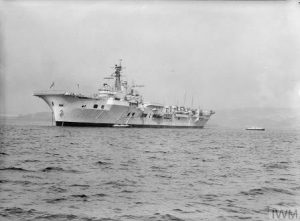In 1896 following the Welsh Intermediate Education Act, a secondary school was opened at North Road, Whitland. Extended several times over the coming years, this original building is still in use, and has seen the change from secondary to grammar and now comprehensive schools. Whitland was sadly was the last grammar school in Wales, after it was renamed Dyffryn Taf Comprehensive in 1989, as a result of the reorganisation of secondary education in the Narberth, Whitland and St Clears area, and the closure of Whitland Grammar School and Ysgol Gruffydd Jones at St. Clears. The school is set in fourteen acres of playing fields, which include rugby pitches, tennis courts, a 100 metre sprint track and an 800 metre running track. I had the privilege to attend Whitland Grammar School from 1980 to 1985, so it is my honour to commemorate on this page the fellow members of the school who fell during both world wars, several from my home village of Laugharne.
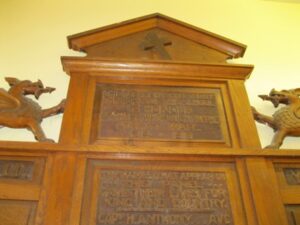
The Great War, 1914-1918
Harry Leonard Anthony, MID, Captain, Royal Army Veterinary Corps. Harry was the son of Mr. and Mrs. John Anthony, of Kidwelly. He had served in the South African campaign of 1901 to 1902, and after returning home served as Veterinary Surgeon to the Tredegar Iron and Coal Company. At the outbreak of the Great War Harry rejoined the Colours, serving with the Pembroke Yeomanry. Harry then served with the 1/1st Lancs Mobile Section, Royal Army Veterinary Corps, which was attached to the 66th (2nd East Lancs) Division, arriving in France on 10 March 1916. By 1917 the Division was stationed around Arras, and took a leading role in the Battle of Arras. On 2 May 1917 Harry was stationed at Arras, when he was killed by a bomb dropped by a German aeroplane. He was 40 years old, and was buried with full military honours at Faubourg D’Amiens Cemetery, Arras, France. Harry was one of six brothers who served during the Great War; two of his brothers, Jack and Ivor, had won the Grand National; Jack being a three time winner as a rider in 1911, 1915 and 1920, and Ivor a two times winner as a trainer. Harry is commemorated at Llangendeirne.
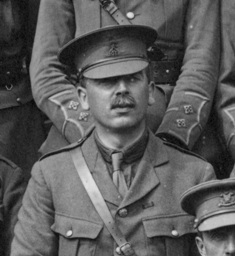
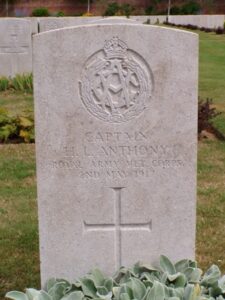
John Bowen, Private, 59427, Royal Welsh Fusiliers. John was born in Llanboidy, the son of Thomas and Mary Bowen, later of Maes-y-Bryn, Clynderwen. John probably worked at Pontardulais, as he enlisted there into the army. He was posted to the 2nd Battalion, Royal Welsh Fusiliers, who had been in France since 11 August 1914, probably joining them at Arras early in 1917. The battalion was then attached to 19 Brigade, 33rd Division, with whom they fought during the Somme Battles of 1916, The Battles of Arras in 1917, and during the Battle of Third Ypres, or Passchendaele. On 6 February 1918 the Battalion again transferred, this time to the 115 Brigade, 38th (Welsh) Division. It was with the Welsh Division that the 2nd RWF took part in the major British offensives of 1918, after the German armies had burnt themselves out with their desperate Spring offensive of 1918. The Division fought over the old Somme Battlefield, pushing the Germans back toward the Hindenburg Line, and took part in the Battle of Havrincourt on 12 September 1918, when the battalion took up positions in the front near Gouzeaucourt. John was sadly killed in action that day, aged only 22. He is buried at Gouzeaucourt New British Cemetery, France. John is commemorated in the Memorial Hall at Whitland, at Pontardulais, and also on the Llandysilio Memorial.
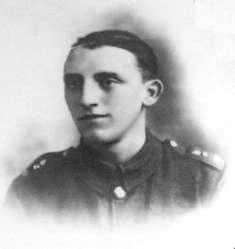
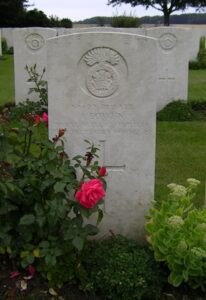
John Tyssil Davies, Lieutenant, Royal Navy. John was born at Llandyssilio on 24 February 1879, the son of the Reverend Daniel Samuel Davies and Mrs Margaret Davies. After being educated at Whitland Grammar School, John’s father took up the post of Vicar of Llanybri, and the family moved there as a result. John seems to have served with the Merchant Navy prior to the war, after being awarded his Board of Trade Certificate on 4 September 1906. He then married Sybil Evelyn H. H. Harding in Montgomeryshire in 1908, and the couple set up home at Park Villa, Llanstephan. After the declaration of war, John decided to enlist into the Royal Navy, and served aboard the Transport Ship Pardo before being granted a commission as Sub-Lieutenant into the Royal Naval Reserve on 14 September 1915. John trained at Devonport, before serving at HMS Vivid, HMS Vengeance II and HMS Dido. On 15 May 1917 John was posted to the pre-dreadnought battleship HMS Hindustan, which was attached to the Nore Command, based at Sheerness. John served aboard for several months, and became promoted to Lieutenant. He became ill with appendicitis, and was hospitalised at the RN Hospital Chatham. After undergoing an operation, John sadly died on 21 January 1918, aged 37, and is buried at Gillingham (Woodlands) Cemetery, Kent. John is also recorded on the Llanstephan Memorial, and also at Mumbles, where his brother, Reverend Latimer Davies, was curate of Oystermouth Parish Church. Sybil later resided at 8, St. Helena Road, Westbury Park, Bristol, and died at Weston-Super-Mare in 1963.
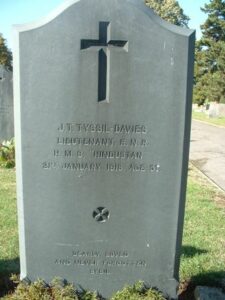
Thomas Howell Davies, Captain, South Wales Borderers. Thomas was born at St. Clears in the winter of 1886, the son of Thomas and Anne Davies, of the Holly Bush Inn, Station Road. His father was a Coal and Lime Merchant. By 1901, Thomas was living with his Grandfather at Waungron Farm, Whitland, and he was educated at Whitland Grammar School. Thomas became a Schoolmaster at Llanybydder prior to the war, and at the outbreak of war enlisted into the London Rifles. Thomas was by then living in London, and he married Edith Newman there in 1916, before being commissioned into the South Wales Borderers on 23 January 1916, and was posted to France with the 11th Battalion, South Wales Borderers, which formed part of 115 Brigade, 38th (Welsh) Division. Thomas fought with the Division throughout the war, at Mametz Wood in 1916, at Pilckem Ridge in 1917. Thomas was probably gassed whilst the 38th Division was at Armentieres early in 1918, before the 11th SWB were disbanded in February 1918, and was invalided back to Llain-y-Gors, Ystradgynlais, where Edith had set up home with their young son. Thomas succumbed to his gas wounds, and died on 6 October, 1919 aged 33. Thomas is buried at Ystradgynlais (St. Cynog) Churchyard.
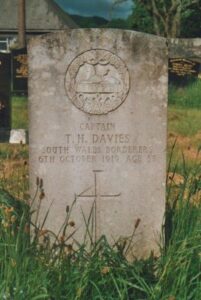
Willie Davies, Fourth Engineer Officer, Mercantile Marine. Willie was the son of Henry and Sarah Davies, of Cwmfelin Mynach. He served as an engineer with the Merchant Navy, aboard the SS Guildhall. Guildhall was built by Tyne Iron Shipbuilding Co. Ltd., Newcastle in 1898, and owned Letricheux Line, Ltd., Swansea. On 25 June 1917, Guildhall was on a voyage from Valencia to Cardiff with a cargo of ore and oranges, when she was sunk by the German submarine U-62, with the loss of twelve lives. Willie was among the men lost. He was 21 years old, and is commemorated on the Tower Hill Memorial, London.
David John Evans, Private, 2459, Welsh Guards. David was born on 27 February 1896, the son of Job and Sophia Evans, of Fronfelin, Cwmbach. Educated at Cwmbach Council School and at Whitland, David had gained employment at Porth with a firm of General Merchants. He enlisted at Porth on 18 December 1915 into the 1st Battalion of the newly formed Welsh Guards. The Welsh Guards had been formed in February 1915, and on 17 August 1915 embarked at Southampton for France, and they arrived at Le Havre that day. On 27 September the Battalion left Le Havre for Loos, as part of 3rd Guards Brigade, Guards Division. They fought during the Battle of Loos, before moving to Ypres in June 1916. David joined the Battalion at Ypres in June 1916. In September they moved to the Somme, where they remained until the end of November. After a spell in reserve, they moved north to Ypres again, and they fought at Third Ypres before moving to take part in the Cambrai Offensive. David was Killed in Action at Cambrai on 1 December 1917, and was buried by his comrades at Gouzeaucourt. A Cross was erected to mark his grave. Sadly the grave was lost during the continued fighting in the area, and so David is remembered on the Cambrai Memorial, Louverval, France.
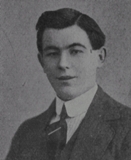
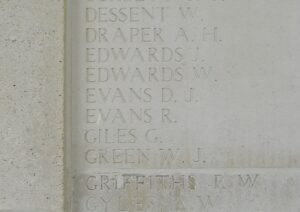
Gwilym Tyndale Evans, Private, 10765, Royal Fusiliers. Gwilym was born in Llandyssilio, the son of the Rev. J. J. Evans, and Mrs. Charlotte Evans, later of Glan Rhydwilym, Clynderwen. He enlisted at Haverfordwest into the 26th (Bankers) Battalion, Royal Fusiliers, part of 124 Brigade, 41st Division. The Division were in France by 6 May 1916, and took part in the Battles of Flers and Le Transloy on the Somme, before moving North to Ypres, where they fought at the opening of the Passchendaele Offensive, at Messines, and at the Battle of Pilckem alongside the 38th (Welsh) Division. On 23 September 1917, the Division were in the midst of the Battle of the Menin Road, when Gwilym was Killed in Action. He was aged only 20, and his body was lost in the Flanders mud. He is remembered on the Tyne Cot Memorial, on Panel 28-30.
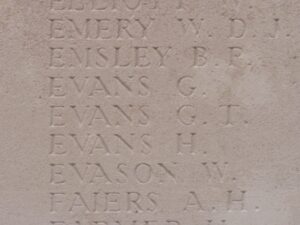
William Evans, Private, 51596, Royal Welsh Fusiliers. William was the son of Isaac and Mary Evans, of Cold-Blow, and the husband of Martha Evans, of Plas Cottages, Church Street, Narberth. There is not much information available on him, but he served in the 3rd Battalion, Royal Welsh Fusiliers, after probably serving abroad. This was a Home Service Battalion that had began the war at Pembroke Dock. They moved to Headquarters at Wrexham on 9 August 1914, and moved to Litherland near Liverpool in May, 1915. The Battalion moved to Ireland to deal with the rebellion during August, 1917 and remained there for the duration of the war, stationed at Limerick. William died at home on 26 April 1921 aged 52, and is buried at Narberth Cemetery.
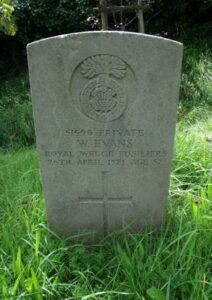
William John Howells, Captain, Welsh Regiment. William was born in White Lion Farm, Eglwys Cummin, in 1888. His Grandfather was Ben John of Brook, who William was living with before he enlisted. William was educated at Tremoilet School and Whitland Grammar Schools, before gaining a BA with Honours at Aberystwyth University. He then moved on to work in Lampeter University before the war broke out. William enlisted into the Welsh Regiment at the outbreak of hostilities, and was commissioned into the 8th Battalion, the Welsh regiment as a Lieutenant. The 8th Battalion formed at Cardiff during August 1914 as part of K.1. They were then attached to 40 Brigade, 13th Western Division. The Division assembled at Salisbury Plain, and then moved to Chiseldon and Cirencester in September 1914. Toward the end of February 1915, the entire Division concentrated at Blackdown in Hampshire. On 7 June 1915 orders were received for the Division to move to the Mediterranean, then by 4 July from Alexandria to Mudros-preparing for the landing on Gallipoli. On 4 July 1915 the Division landed on Cape Helles and relieved the 29th Division. From there, the Division took part in several actions, most notably The Battle of Sari Bair between 6-10 August 1915 and the Battle of Russell’s Top on 7 August 1915. The Battalion War Diary for the period from 8 August 1915 shows that they had moved up to positions around Chunuk Bair, in support of the Gloucester’s and the Wellington Battalion. The fighting was ferocious and the diary shows that on that one day, the 8th Battalion suffered 4 Officers and 4 Other ranks killed, 9 Officers and 154 Other Ranks wounded, and 4 Officers and 266 Other Ranks missing in action. One of the wounded officers was Captain William John Howells. William was evacuated from Gallipoli, but died of his wounds on 10 August 1915 aboard the Hospital Ship HMHS Valdivia. William was buried at sea, so he is commemorated on the Helles memorial, Turkey, on Panel 140-144.
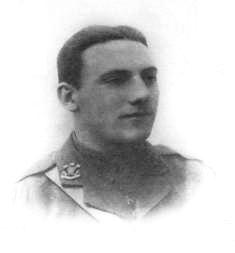
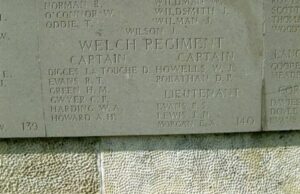
William Robert Hughes, Private, 10117, Royal Welsh Fusiliers. William was born at Llanglydwen. He was probably serving at the outbreak of the Great War, with the 2nd Battalion, Royal Welsh Fusiliers, which moved to France on 11 August 1914, as Lines of Communication troops. On 22 August 1914 the battalion became attached to 19 Brigade, which was not allocated to a Division but was an independent command at this time, then on 12 October 1914 transferred with Brigade to 6th Division. The 2nd RWF fought at Second Ypres in 1915, and on 31 May 1915 transferred with 19 Brigade to 27th Division. On 19 August 1915 it transferred with 19 Brigade to 2nd Division, then on 25 November 1915 transferred with 19 Brigade to 33rd Division. During the evening of 21 June 1916, the 2nd RWF moved into trenches at Givenchy. At around 01.40 on the morning of 22 June 1916, a terrific explosion brought terror to the men posted in the trenches. The Germans had blown a mine beneath the line held by B Company of the 2nd RWF, engulfing two-thirds of its men in tons of earth and debris. William was one of many men killed during the explosion, both above and below ground. He was one of the few men to be recovered from the resulting crater, and is buried at Cabaret Rouge British Cemetery, Souchez, France. The crater was later named the Red Dragon Crater, in honour of the 2nd RWF who defended the position against the resulting German attack.
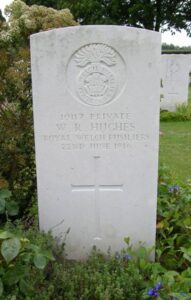
Wynne Glynne Odyerne Hulm, Lieutenant, Devonshire Regiment. Wynne was born on 8 August 1888, the son of Wynne Patrick Hulm and Elizabeth Hulm, of 124, Finborough Road, West Brompton, London. His father was from Saundersfoot and Wynne attended Whitland for a period when the family lived in Pembrokeshire before returning to London. Wynne joined the Artists Rifles in 1908, and after the outbreak of the Great War received a commission into the Devonshire Regiment. He was promoted Lieutenant in 1915 and posted to the 8th Battalion, Devonshire Regiment, which was attached to 20 Brigade, 7th Division. They had landed in France on 26 July 1915 and had been attached to this already battle-hardened Division to train. Wynne was mortally wounded and fell about ten yards from the German lines during his battalions charge on the German lines on the 25 September 1915, the first day of the Battle of Loos. He was carried back to Lapugnoy by his men but died later that day, aged 27. He is buried at Lapugnoy Military Cemetery. The memorial shows Captain G. Hulm, Royal Engineers.
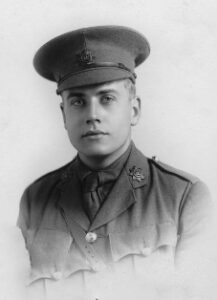
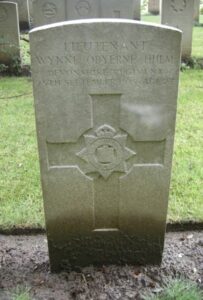
Clifford Jones, Lieutenant, Royal Welsh Fusiliers. Clifford was born in Whitland, the only son of Rev. Daniel Jones (Baptist Minister, Whitland) and Mrs. E. A. Jones, of Bodlondeb, Whitland. Clifford was an Honours Graduate of Wales and Oxon, and was commissioned into the 15th (London Welsh) Battalion, Royal Welsh Fusiliers, which formed part of the 113 Brigade, 38th (Welsh) Division. The Division embarked for France from Folkestone on 5 December 1915, disembarking at Boulogne the same day. During the winter and spring of 1916 the Battalion held the line in the Armentières sector, and at the end of May, 1916 moved South with the remainder of the 38th (Welsh) Division to the Somme area, in readiness for the First Battle of The Somme. After surviving the Battle of Mametz Wood, Clifford moved with the Battalion to reserve in the Ypres sector, and the Division didn’t fight again for almost twelve months, until they were brought into the line north of Ypres, tasked with the taking of the village and strongpoint of Pilckem. Clifford was Killed in Action three days into the Battle of Pilckem, on 2 August, 1917, aged 25. He is commemorated on the Ypres (Menin Gate) Memorial.
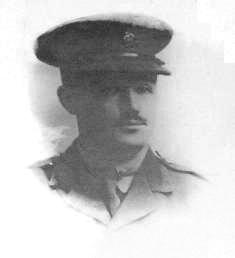
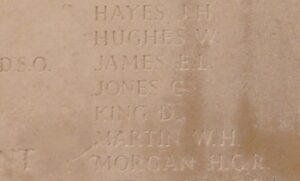
John Charles Lewis, Captain, Monmouthshire Regiment. John Charles Lewis was the son of John and Alice Lewis, of Troedybryn, St. Clears. He was enlisted into the Inns of Court Officer Training Corps, with the Army Number 8113. From here he was commissioned into the 1st Battalion, the Monmouth Regiment, as a 2nd Lieutenant. John was subsequently attached to the 6th Battalion, KSLI from 21 January 1917 onwards, serving with the Battalion on the Somme during the Winter of 1916/17, then with the Battalion at Third Ypres (Passchendaele). The Battalion moved South on 1 October, entraining at Proven for Bapaume. John was promoted Captain, taking over Command of ‘A’ Company, 6th KSLI. They took over the front line trenches at Villers Plouich on 20 October, and took part in the attack on Welsh Ridge, during the Battle of Cambrai, on 20 November 1917. John was mortally wounded whilst gallantly leading his Company into action that day. He was 30 years old. His body was lost in the coming battles in the area, and he is remembered on the Cambrai Memorial, Louverval. John is commemorated on the St. Clears War Memorial.
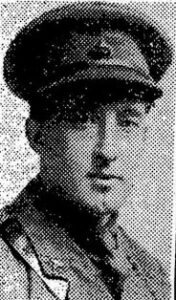
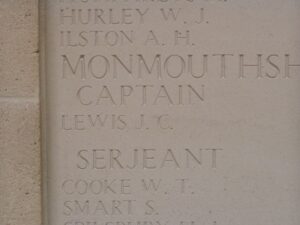
Thomas George Lewis, Gunner, 100593, Royal Garrison Artillery. Thomas, or George as he was better known, was born in Cilfynydd. The family came to live in St. Mary Street, Whitland, and George attended Whitland Council and County Schools, before taking up a post at Lloyd’s Bank in Llandovery. George was engaged to a Miss Thomas, and he enlisted at Llandovery into the Royal Garrison Artillery, being posted to their 48th Heavy Battery, part of the 3rd Brigade, R.G.A. Not much is known of where George fought except that during the spring of 1918 he was at Ypres. The German offensive of Spring 1918 had been launched on 21 March, and they turned their attentions to Flanders a month or so later. George was Killed in Action at Ypres on 30 May, 1915 and is buried at Canada Farm Cemetery. Some time later, his mother received a letter from a Welsh Chaplain who was attached to the Brigade- ‘This is a great shock to you, and I hasten to convey to you personally, and on behalf of the battery to which your son was attached, our greatest sympathy. I understand that he was greatly respected, and that his loss will be felt by all…’ Thomas is commemorated in the Memorial Hall at Whitland, and also on the Llandovery Memorial.
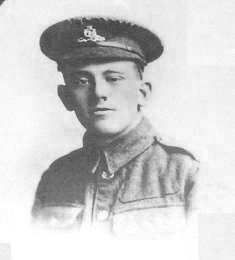
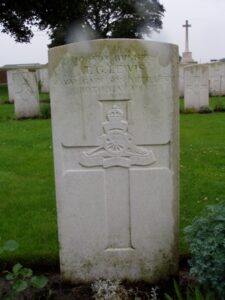
Dan Phillips, Corporal, 40214, Royal Welsh Fusiliers. Dan was the son of William and Anne Phillips, of Blaenhiraeth, Henllan, Whitland. He was educated at Whitland Grammar School and was a student at the South Wales Training College at Carmarthen when he enlisted there into the army and was posted to France in 1916, joining the 10th Battalion, Royal Welsh Fusiliers, which was attached to 76 Brigade, 3rd Division, and had suffered heavy casualties during its first major action, at the St. Eloi craters, south of Ypres. The division moved south to the Somme, entraining at St. Omer on 1 July 1916 and reached Carnoy on 13 July, while the Welsh Division was moving away from the same area following its assault on Mametz Wood. By now Dan had been promoted to Acting Corporal. The 3rd Division moved into the line on 14 July in order to take part in the assault on Delville Wood, Longueval and Bazentin le Grand. The 10th RWF remained in reserve for the initial attack, but would soon be thrown into the fray as on 20 July was given the task of entering Delville Wood and clearing along Princes Street. The battalion suffered heavily before reaching the wood, where South African scouts met them and the 10th RWF advanced into a fierce fight which earned the battalion two Victoria Crosses. The 10th RWF, relieved from Breslau Trench on 25 July, did not go back into action until moving back into the front, reaching Talus Wood on 14 August, and its officers reconnoitred the Casement, Dublin and Chimpanzee trenches in front near Guillemont before taking them over on 15 August and spent much of the day consolidating them, suffering three men killed and four wounded. On the following day the battalion attacked Lonely Trench, but were beaten back, suffering five officers and 116 men killed between 16 and 19 August. Dan was posted as missing during the initial attack on Lonely Trench on 16 August 1916. He was later found to have been killed in action that day. He was 25 years old and is commemorated on the Thiepval Memorial, France. Dan is also commemorated in the Memorial Hall in Whitland and at Henllan Amgoed.
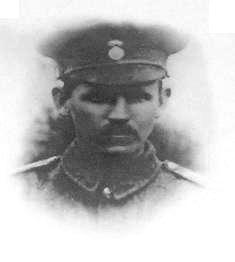
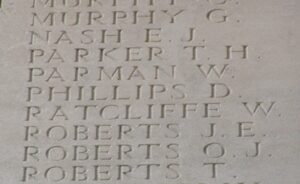
John Thomas, Corporal, S/4253, Rifle Brigade. John was born in St. Clears, the son of John and Eliza Thomas, of Penrhwl Cottage, Ffynongain. He enlisted at Pentre into the 13th Battalion, Rifle Brigade, attached to 111 Brigade, 37th Division. At the end of July, 1915 the Division landed at Boulogne, and moved to the Loos area. Here they fought at the Battle of Loos, and John was mortally wounded at Loos. He died as a result of his wounds on 18 November, 1915 aged 29. John is buried at Humbercamps Communal Cemetery Extension. He is commemorated on the St. Clears War Memorial.
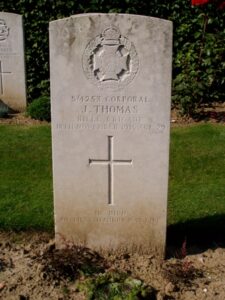
William John Thomas, Private, 65267, Welsh Regiment. William was born at St. Clears, and enlisted at Swansea into the 9th Battalion, Welsh Regiment, which was attached to 58 Brigade, 19th (Western) Division. In July 1915 the Division landed at Havre, and moved to Flanders. They saw action in the Neuve Chappelle area, and then moved to Loos, where they fought in the Battle of Loos. They saw considerable action on the Somme in 1916, and were caught up in the German Spring Offensive of 1918, suffering terrible casualties. William joined the Army in May 1917, made a short visit home on leave in February 1918 before joining the Battalion in France. Sadly he was Killed in Action during the early stages of the Spring Offensive, at the Battle of Kemmel, on 29 April 1918 aged 19. He is remembered on the Tyne Cot Memorial. William is commemorated on the St. Clears Memorial.
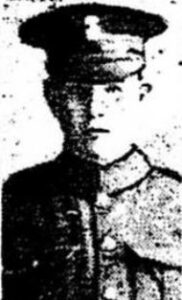
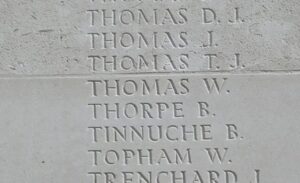
Willie Morris Thomas, Private, 73210, Royal Welsh Fusiliers. Willie was the son of William and Martha Thomas, of Brynawel, Henllan Amgoed, Whitland. He enlisted at Carmarthen originally into the South Wales Borderers, but transferred into the 9th Battalion, Royal Welsh Fusiliers, part of 58 Brigade, 19th (Western) Division. The Battalion landed at Boulogne on 19 July 1915 and fought during the Battle of Loos, the Battle of the Somme, and the Battles of Third Ypres, gaining themselves a reputation as one of the best Divisions on the Western Front. The Division suffered heavily during the German Spring Offensive, being caught up in the German attack on the Eastern Somme sector during the First Battle of Bapaume, and Willie was killed in Action in the area between Achiet-Le-Petit and Sailly-Au-Bois on 26 March 1918, aged just 19. He is buried in H.A.C. Cemetery, Ecoust-St. Mein, France. Willie is commemorated in the Memorial Hall, Whitland.

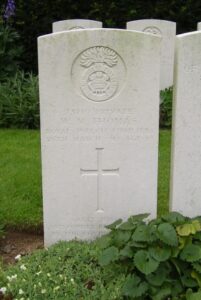
Charles Vincent Todman B.A., Lieutenant, Royal Air Force. Charles was born in Victoria Street, Laugharne on 12 January 1892, the son of William and Matilda Todman. He had three sisters, Margery, Maud and Ivy, who all served as Nurses in the war, and two brothers; John Thomas Todman served with the 1st Australian Tunnelling Company, and another served in the Infantry. The family later moved to Cricklewood, London, where Charles was educated at the University of London, gaining his B.A. before taking a job as a Teacher, employed by the London County Council. Charles enlisted into the army in April 1914, joining the 9th Battalion (Queen Victoria’s Rifles), London Regiment, which was attached to 13 Brigade, 5th Division. They landed at Le Havre on 5 November 1914, and fought through the Battles of Mons, Le Cateau, the Marne, the Aisne, La Bassee, Messines and the First Battle of Ypres. On 18 March 1915, Charles was promoted to Corporal, before being granted a Commission into the 10th Battalion (Hackney), London Regiment. He served with the 175th Trench Mortar Battery throughout the Battle of Passchendaele, before being evacuated to Hospital in England with severe Gas Wounds on 12 September 1917. Following an operation to remove his damaged tonsils, Charles left Hospital in Chelsea on 4 December 1917, and on 23 May 1918 was listed in the London Gazette as being appointed as a Lieutenant (Flying Officer) with the newly formed Royal Air Force, in Number 16 Squadron. Number 16 Squadron formed part of 41 Wing, based at Ochey in France, and was commanded by Lieutenant-Colonel C.L.N. Newall. It mounted its first attack against a factory at Saarbrucken in Germany on 17 October 1917, and a week later carried out a night attack against the same target. The wing was later expanded with the inclusion of numbers 99 and 104 Squadrons. From June 1918, the wing gained greater involvement in bombing missions in Germany flying the RE-8 aeroplane from their new base at Camblain-l’Abbé. From there the Squadron were used in support of the First Army at their junction with the Second Army at Armentieres. Charles was acting as an Observer in an R.E.8, serial Number C2518 piloted by Lieutenant Percy West, on 3 August 1918, when they were attacked by three German Aircraft East of Vimy Ridge, whilst on Artillery Observation. After a brave fight, their attackers finally drove them down near Aubigny, and both men sadly died in the resulting crash, which was claimed as a victory by Leutnant Paul Billick of Jasta 52. Charles was buried at Aubigny Communal Cemetery, France, alongside his fellow airman Percy West. He is commemorated on the Laugharne War Memorial.
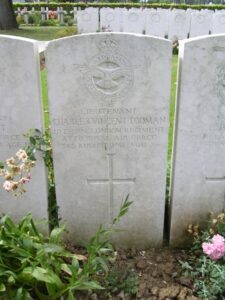
Idris John Williams, Private, 13924, Royal Welsh Fusiliers. Idris was born at Ffynonwen, Login on 6 December 1897, the son of David and Mary Ann Williams. He was educated at Whitland Grammar School before the family moved to Rock House, Tumble, Llanelly. He enlisted at Tumble on 5 September 1914 into the 11th Battalion, Royal Welsh Fusiliers, part of 67 Brigade, 22nd Division. The Division landed in France in September, 1915, but were sent to Salonika almost immediately, landing there by 5 November. It was in Salonika that Idris contracted typhus. He died on 29 March 1916, aged 19, and is buried in Salonika (Lembet Road) Military Cemetery.
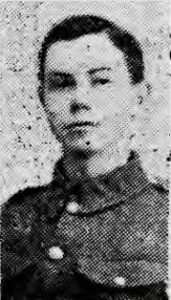
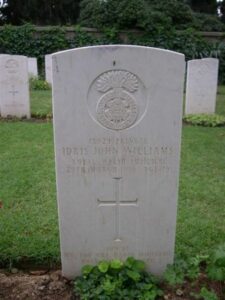
World War Two, 1939-1945
Dalis George Davies, Pilot Officer, 48776, Royal Air Force Volunteer Reserve. Dalis was the son of Benjamin and Annie Davies, of Whitland. Dalis was sent to Canada to undergo Pilot training, through the British Commonwealth Air Training Plan. This scheme in Canada produced thousands of well trained aircrew, more than enough to keep the various air forces of the Commonwealth supplied with men throughout the course of the war, but thousands died whilst training in Canada, and one of these unfortunate men was Dalis, who died when his aircraft crashed on 8 September 1942, aged 24. He is buried at Caron Municipal Cemetery, Ontario. Dalis is commemorated in the Memorial Hall, Whitland.
Elwyn Bartlett Evans, Ordinary Seaman, C/JX 228643, Royal Navy. Elwyn was born near Narberth in 1912, the son of David T. Evans and Edith S. Bartlett. He served as a Royal Navy seaman aboard the Merchant Ship MV Pelayo. On the morning of 15 June 1942, the German submarine U-552 attacked the convoy HG-84 about 400 miles WNW of Corunna and sank three ships, Etrib, Pelayo and Slemdal. The Pelayo was the ship of the convoy commodore H.T. Hudson RNR RD. The commodore, eleven crewmembers, three gunners and two naval staff members were lost. Elwyn was among the dead. He is commemorated on the Chatham Naval Memorial, Kent.
Emrys Evans, Pilot Officer, 119172, Royal Air Force Volunteer Reserve. Emrys was born in Whitland, the son of Gwilym and Anne Evans. The family later lived in Johnstown, Carmarthen. Emrys had graduated from University with a B.Sc. from the Welsh Board of Education, but had enlisted into the R.A.F.V.R., joining 156 Squadron as an Air Gunner. 156 Squadron were formed at Alconbury in 1942 as a medium bomber squadron, flying the Vickers Wellington Mark III, and operated with No. 3 Group. Emrys was commissioned into the Squadron from Flight Sergeant on 21 March, 1942. On 30 May, 1942 a massive raid was launched by Bomber Command on Cologne. 1,047 aircraft took to the sky, amongst them was the Wellington X3598 of Emrys Evans and his crew, under the command of Pilot Officer Bain D.F.C. 898 aircraft managed to drop their deadly cargoes on the city, causing terrible fires, before turning around and heading for home. Emrys and his crew were intercepted and shot down over Holland on the return journey, at 00.35 on the morning of 31 May 1942. Emrys and his five other crew-mates died in the crash, aged 25 and is buried at Bergen-Op-Zoom War Cemetery. Emrys is commemorated in the Memorial Hall, Whitland.
Gordon Wreford Griffiths, Leading Aircraftman (Pilot), 1315678, Royal Air Force Volunteer Reserve. Gordon was born in Pembrokeshire in 1921, the son of Alfred and Winnifred Ann Griffiths. The family later moved to Mount Pleasant, Swansea. Gordon volunteered to serve with the RAFVR, and was training as a Pilot when he was killed whilst flying Oxford I, R6072 of No 3 SFTS, which collided with Oxford N6267 of the same unit near Fishguard on 26 October 1941. Gordon was 20 years old, and is buried at Llanwnda Cemetery, Goodwick. He is commemorated at the Memorial Hall, Whitland.
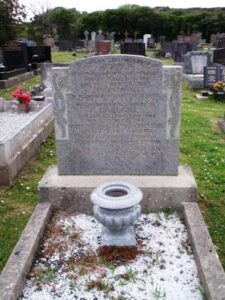
Ellis Lyn Howells, Corporal, 4198127, Parachute Regiment. Ellis was the son of John Howell Howells and Mary Margretta Howells, of St. Clears. Prior to the outbreak of war, he worked in the G.W.R. Office at Carmarthen. He enlisted into the 10th Battalion, Royal Welch Fusiliers, but had volunteered, and was accepted, into the 6th Battalion, Parachute Regiment. The battalion was sent to North Africa to take part in Operation Torch, the landings on French North Africa on 8 November 1942. After a bitter campaign, the Germans crumbled, and the British took Tunis on 8 May 1943. Ellis was accidentally shot, and died on the way to Hospital on 11 May 1943. Just three days later the Germans surrendered. Ellis was 25 years old, and is buried at La Petit Lac Cemetery, Tunisia. He is commemorated on the St. Clears War Memorial.
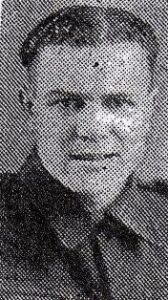
John Baldwin James, Corporal, 3915984, Monmouthshire Regiment. John was born near Narberth in 1923. He served with the 3rd Battalion, Monmouthshire Regiment. The Battalion was mobilized for war as part of the 53rd (Welsh) Division in Northern Ireland. It trained in Northern Ireland in 1940 and returned to England in 1941. In the summer of 1942 it was transferred to the 11th Armoured Division and trained for armoured warfare. It was destined for North Africa and its advance parties actually embarked, and sailed there, but the move was cancelled, and these men were lost to the battalion. The battalion landed in Normandy on 14 June 1944, and took part in the break out from the beach-head, and in the drive through northern France into Belgium and Holland over the coming weeks. The important port of Antwerp was liberated after hard fighting on 4 September 1944, and it was on this historic day that John was killed. He was just 20 years old, and is buried at Schoonselhof Cemetery, Belgium.
John Lloyd James, Sergeant, 3963431, Royal Armoured Corps. John was the son of Mr. and Mrs. John James, of St. Clears, and the husband of Dilys James, of 7, Corvus Terrace, St. Clears. He enlisted prior to the outbreak of war into the 4th Battalion, the Welsh Regiment (the Carmarthenshire Territorials), and upon the outbreak of war, was transferred into the 2nd Battalion, Derbyshire Yeomanry, part of the Royal Armoured Corps. John served in North Africa with the Yeomanry, before their recall to England to train for the invasion of Europe. The Derbyshire Yeomanry landed in Normandy during D-Day, 6 June 1944. The Derbyshire Yeomanry was serving as a divisional Reconnaissance Regiment, attached to 51st (Highland) Division. After landing in Normandy, 51st (Highland) Division was moved across Pegasus Bridge to the east bank of the River Orne. There it was to strengthen the bridgehead of the 6th Airborne Division, which had been under extreme pressure since D-Day from 21 Panzer-Division and the freshly-arrived 346 Infanterie-Division. After a disastrous first battle at Breville on 10 June, the division was moved in on the southern flank of the bridgehead and into the already-notorious Escoville Triangle. The 2nd Derbyshire Yeomanry guarded bridges but took part in the bitter fighting for the villages of Escoville and Herouvillette, being employed mainly in an infantry role. In four days, casualties were almost 50, including the CO, Lt Col RH Palmer, but three MCs and four MMs were awarded. John was one of the fifty men of the unit to be killed during this period. He was killed in action on 16 June 1944, aged 29, and is buried at Ranville War Cemetery. He is commemorated on the St. Clears War Memorial.
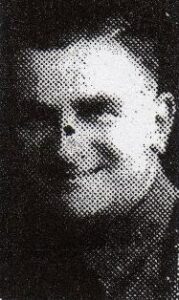
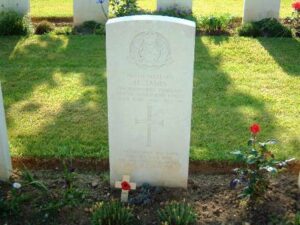
John Wynford Jones, Flight Sergeant, 1062633, Royal Air Force Volunteer Reserve. John served in 103 Squadron, R.A.F., which was reformed in 1936 due to the growing German threat. They were based in France at the outbreak of war, as part of the Advanced Air Strike Force, equipped with the obsolete Fairey Battle, but were withdrawn in June 1940 when the situation in France became critical. After spells at RAF Abingdon and Newton, they took up permanent residence at R.A.F. Elsham Wolds in July 1941, as part of 1 Group, Bomber Command. By now they had been re-equipped with the Vickers Wellington, and were taking part in the 1,000 bomber raids on Nazi Germany. In July 1942 they were equipped with the Halifax, but they proved to be not up to the job, and after heavy losses the squadron converted to Lancasters three months later. They squadron now took part on bombing missions over the industrial Ruhr Valley, and on 22 June, 1943 took off as part of a 557 aircraft raid on Mulheim. The town was almost completely destroyed, but John and his Lancaster must have been shot down on the return flight, as John was killed the following morning on 23 June, 1943. He is remembered on the Runnymede Memorial. John is commemorated at the Memorial Hall at Whitland.
Wilfred Austen Lewis, Sergeant, 974474, Royal Air Force Volunteer Reserve. Wilfred was the son of David and Charlotte Lewis of Lewis Terrace, St. Clears, and the husband of Dorothea Maud Lewis, of Llanelly. Wilfred worked prior to the war as a Reporter on the ‘Welshman’ Newspaper, and was well known locally. He served as a Flight Sergeant in 172 Squadron, RAFVR, who were based at Skitten flying the Vickers Wellington medium bomber. Wilfred was killed on a raid on 2 April 1943 aged 28 and is remembered on the Runnymede Memorial. He left behind his wife and a baby boy.
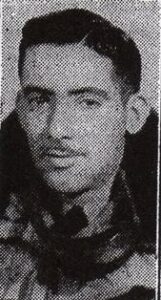
Walter Hugh Morgan, Signalman, 2362588, Royal Signal Corps. Walter was born on 5 August 1918, the son of Henry David and Lilian Edith Maude Morgan, of Compton House, Llanfallteg. He was serving as a signaller with the Trades Services Battalion, but contracted appendicitis on active service. Walter died under anaesthetic at St. Asaph on 3 January, 1940 aged just 22. He was buried with full military honours in Henllan-Amgoed Congregational Chapelyard. His brother Parry died in Burma in 1943.
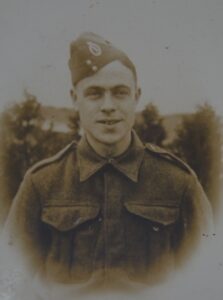
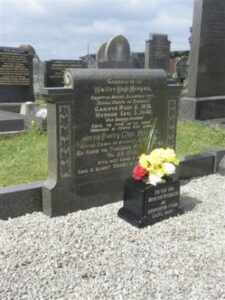
Austin Thomas Phillips, Leading Stoker, D/KX 91896, Royal Navy. Austin was born on 29 January 1918, and was the son of Richard Lewis Phillips and Mary Winifred Phillips of Brook Cottage, near Laugharne. Austin was married to Margaret Winifred Phillips and they had a daughter Rose Mary Phillips. Austin was a pupil of Brook School, before he went to Whitland Grammar School at 11. After leaving school at 17 years old, Austin went to work at Great House Farm, Laugharne, before enlisting into the Royal Navy at 19 years old on 17 August 1937. Training was thorough in the Royal Navy, and Austin spent time training at several Naval Bases including Drake and Tamar-before getting a posting on the ship HMS Glenearn on 12 December 1940. He was now a Stoker 1st Class. HMS Glenearn was commandeered by the Royal Navy in October 1939 and converted into a Fast Fleet supply Ship. Her role was to supply fuel and ammunition to secret Atlantic Squadrons-tasked with the destruction of German surface ships in the Atlantic, but the withdrawal of the British Expeditionary Force from Dunkirk in 1940 meant that she was brought into service to aid in the evacuation of the besieged forces from the famous beaches. She was then converted to a Troopship-capable of carrying 1090 troops, 12 small Landing Craft and 2 large Landing Craft. In April 1941 she was sent to Malta, along with her sister ship the Glengyle and on 19-20 April was used in the first ever Commando assault from specialised ships. On 22 April, while assisting in the evacuation of Greece, she received a direct hit on the foc’sle but remained operational, and on 26 April was hit twice more. She had to be towed to Crete by the destroyer HMS Griffin, and then to Alexandria. After the evacuation of 50,672 troops from Greece, she sailed through the Suez Canal, and was hit by a burning ship, and had to go to Colombo for repairs. In mid 1942 she returned to England and was fitted with davits to handle larger Landing Craft and was used in the Allied landings on D-Day on Sword Beach. In 1945, Glenearn was sent to the Far East to join the Pacific Fleet, but in April was damaged by a fuel explosion while she was near the mouth of the Markham River, Papua New Guinea. Several crem members were seriously wounded by the explosion, and died over the coming days. Austin was evacuated to Hollandia Hospital on Papua New Guinea. Sadly on 15 April 1945, Austin died as a result of his burns. He was aged 27. Austin was originally buried at Hollandia Hospital Cemetery, but after the War, the Graves from outlying cemeteries were brought into Lae, as it was impossible to maintain the smaller outlying cemeteries. Austin had survived some of the greatest and most famous conflicts of WW2, Dunkirk and D-Day, and sadly died in an accidental explosion on board ship. He left behind his young Widow Margaret and his 17-month-old daughter Rose Mary. He lies buried at Lae war cemetery, Papua New Guinea, in grave FF.A.10. Austin is commemorated on the Laugharne War Memorial, and also at Pendine.
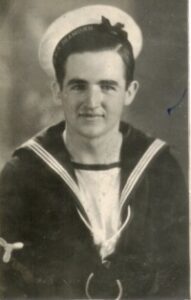

Denzil Jonah Thomas, Leading Aircraftman, 651354, Royal Air Force Volunteer Reserve. Denzil served in 30 Squadron, R.A.F.V.R., which had originally been formed in Ismailia in 1915. Prior to the outbreak of WW2, the Squadron were in Iraq, but moved to Egypt by 1938, flying Blenheims. They flew bomber escort duties in North Africa, and moved to Greece when invasion was imminent, but when Greece fell were hurriedly evacuated to Crete, being stationed at Maleme Airfield. The Battle of Crete began on 20 May 1941, with Junkers transport planes dropping scores of elite German Paratroopers near the airfield. Denzil was killed in the Battle of Crete on 20 May 1941 and is remembered on the Alamein Memorial. Denzil is commemorated in the Memorial Hall at Whitland, and is also on the Llanboidy Memorial.
Thomas David Thomas, Gunner, 1605265, Royal Artillery. Thomas was the son of Thomas and Catherine Thomas, of Hebron, Carmarthenshire. He had studied for his B.Sc. prior to the war, before joining the Royal Artillery, serving with the 3rd Heavy Anti Aircraft Regiment, RA. The Regiment served in the Far East. Thomas was captured by the Japanese, and was sent to work on the Burma-Siam Railway. Sadly Thomas died in captivity in Burma, on 6 December 1943 aged 30. He is buried at Thanbyuzayat War Cemetery, Myanmar.
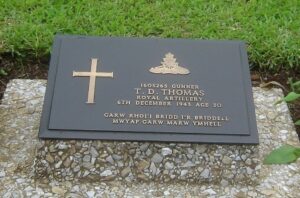
Post WW2
William Howell Morse, Lieutenant, Royal Navy. William was born at New Mill, Laugharne on 18 January 1931, the son of William Twin Morse and Sarah Ann Morse (nee Howells). He was educated at Whitland Grammar School, and after leaving in 1946, passed his entrance exam for the Royal Navy. He originally joined as an Artificers Apprentice and passed out four years later as a Petty Officer. The Royal Navy was looking to recruit pilots at the time, so William applied, and was accepted. After undertaking further officer training, William undertook flying training at RAF Lossiemouth in Scotland. He then successfully passed his jet conversion training before joining 800 Squadron, Fleet Air Arm at Brawdy in March 1955. After six months at Brawdy, during which time William flew over New Mill several times, the Squadron was posted to HMS Ark Royal for her maiden voyage to the Mediterranean. On 14 October 1955 Ark Royal passed through the Straits of Gibraltar. William was the first man to take off that day, but the catapult failed, and without the extra boost in speed to get airborne, Williams’ aircraft plunged off the deck into the sea. The ship was stopped and a search was carried out, but there was no trace of William nor his aircraft. William was 24 years old when he died that day, and is commemorated on the Armed Forces Memorial at Alrewas, Staffordshire. Many thanks to Walter Morse for sending in the information about his brother William. There is no memorial for post WW2 casualties within the school.
